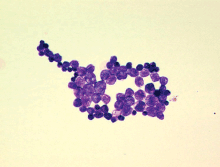Prototheca
| Prototheca | |
|---|---|

| |
| Scientific classification | |
| (unranked): | Viridiplantae |
| Phylum: | Chlorophyta |
| Class: | Trebouxiophyceae |
| Order: | Chlorellales |
| Family: | Chlorellaceae |
| Genus: | Prototheca Krüger, 1894[1] |
| Species | |
Prototheca is a genus of algae in the family Chlorellaceae.[2] All the species within this genus, even though classified as green algae, have forfeited their photosynthetic ability and have switched to parasitism. Some species can cause the disease protothecosis, otherwise known as Algaemia.
Symptoms include: Cutaneous lesions, Olecranon bursitis.
Etymology[]
From the Greek proto- (first) + thēkē (sheath), Prototheca is a genus of variably shaped spherical cells of achloric algae in the family Chlorellaceae. , a German expert in plant physiology and sugar production, reported Prototheca microorganisms in 1894, shortly after spending 7 years in Java studying sugarcane. He isolated Prototheca species from the sap of 3 tree species. Krüger named these organisms as P. moriformis and P. zopfii, the second name as a tribute to Friedrich Wilhelm Zopf, a renowned botanist, mycologist, and lichenologist.[3]
References[]
- ^ Krüger, W. (1894). Kurze Charakteristik einiger niedrerer Organismen im Saftfluss der Laubbäume. Hedwigia 33: 241-266, [1].
- ^ See the NCBI webpage on Prototheca. Data extracted from the "NCBI taxonomy resources". National Center for Biotechnology Information. Retrieved 2007-03-19.
- ^ Ollhoff, Rüdiger D.; Sellera, Fábio P.; Pogliani, Fabio C. (November 2021). "Early Release -Etymologia: Prototheca". Emerg Infect Dis. 27 (11). doi:10.3201/eid2711.211554. Retrieved October 8, 2021.
Citing public domain text from the CDC.
External links[]
- Trebouxiophyceae genera
- Chlorellaceae
- Green algae stubs